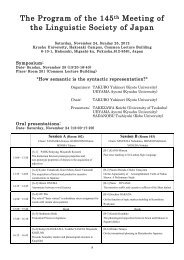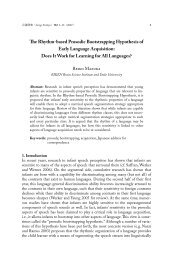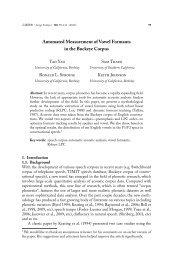第117åæ¥æ¬è§£åå¦ä¼ç·ä¼ã»å ¨å½å¦è¡éä¼ è¬æ¼ããã°ã©ã ã»æé²é PDF ...
第117åæ¥æ¬è§£åå¦ä¼ç·ä¼ã»å ¨å½å¦è¡éä¼ è¬æ¼ããã°ã©ã ã»æé²é PDF ...
第117åæ¥æ¬è§£åå¦ä¼ç·ä¼ã»å ¨å½å¦è¡éä¼ è¬æ¼ããã°ã©ã ã»æé²é PDF ...
You also want an ePaper? Increase the reach of your titles
YUMPU automatically turns print PDFs into web optimized ePapers that Google loves.
117 119<br />
OHPMIV<br />
<br />
<br />
<br />
<br />
<br />
<br />
<br />
<br />
<br />
<br />
<br />
<br />
1 MAL <br />
<br />
2 <br />
<br />
MAL <br />
<br />
<br />
<br />
<br />
OHPMIV<br />
D <br />
<br />
<br />
<br />
<br />
Saito et al., 2006, Steinke H et al., 2009<br />
<br />
3D <br />
<br />
5 <br />
<br />
<br />
MRI LaserErgo Scanner <br />
<br />
3D <br />
<br />
<br />
3D 3 <br />
<br />
Saito et al, Surg Radiol Anat 28, 228234, 2006<br />
Steinke H et al. Ann Anat 191, 408416, 2009<br />
OHPMIV<br />
<br />
1 2 3 3 4 3<br />
1<br />
2 3 4 <br />
<br />
2 <br />
19%<br />
<br />
<br />
1 <br />
<br />
Gray’s Anatomy <br />
Gottshalk 1989<br />
3 <br />
Akita 1993<br />
<br />
3 <br />
<br />
<br />
<br />
1 0.8 <br />
<br />
<br />
OHPMIV<br />
<br />
1 2 2,3<br />
1<br />
2 3 <br />
<br />
<br />
7<br />
12 <br />
3 <br />
<br />
<br />
<br />
<br />
67<br />
33<br />
1/31/6 50<br />
50<br />
<br />
<br />
<br />
<br />
<br />
<br />
<br />
OHPMIV<br />
Threedimensional modeling of the architecture of the plantar<br />
muscles of the great toe<br />
Takamitsu Arakawa 1,2 , Anne Agur 1<br />
1<br />
Division of Anatomy, Department of Surgery, Faculty of Medicine, University of<br />
Toronto, 2 Kobe University Graduate School of Health Sciences<br />
The plantar muscles of the great toe are involved in many foot pathologies,<br />
including hallux valgus. Forces acting along their tendons are important<br />
considerations in analyzing gait patterns and arch stability. Muscle models have<br />
not been constructed at the fiber bundle level, but rather using a series of single<br />
or multiple line segments to represent a muscle. The purpose of this study is to<br />
construct, at fiber bundle level, a volumetric 3D model of the plantar muscle of<br />
the great toe. In situ digitization with a Microscribe TM G2DX digitizer of one<br />
formalin embalmed cadaveric specimen was used to develop a 3D prototype<br />
model of abductor, adductor, and flexor hallucis muscles. Autodesk ® Maya ® , with<br />
additional plugins developed in this laboratory, were used to create a model the<br />
digitized data. Using this technique, a detailed model at the fiber bundle level was<br />
constructed and used to visualize and quantify the musculotendinous architecture<br />
of the plantar great toe muscles. This prototype may be further developed into<br />
a contractile model that enables functional analysis in normal and pathologic<br />
scenarios.<br />
OHPMI<br />
The characteristic of the filiform and fungiform papillae of human<br />
tongue<br />
ShineOd Dalkhsuren, Kikuji Yamashita, Dolgorsuren Aldartsogt,<br />
Kaori Sumida, Shinichiro Seki, Seiichiro Kitamura<br />
<br />
Objective: We aimed to clarify whether there are the structurally differences of the<br />
filiform and the fungiform papillae of human tongue depending on their position<br />
and function.<br />
Methods: The tissue specimens were separated to the significant parts: the tip, the<br />
body and the root of tongue and processed with the scanning electron microscopy<br />
SEM JCM5700, Jeol, Tokyo, Japan and the light microscopy.<br />
Results and discussions: The tip of tongue is the first sensing place for taste<br />
stimuli and the most active moving side. Consequently, the free longbased<br />
fungiform papillae distributed equable densely and a few filiform papillae<br />
containing the less and strong hairs placed along the margin of the fungiform<br />
papillae. The body of human tongue is the main mastication area. And it contained<br />
the numerous filiform papillae which are composed of a lot of hairs for making<br />
the soft sponge structure and holding the tongue plaque. In the root, the both of<br />
filiform and fungiform papillae were changed responding to the frictional stress as<br />
the swallowing.<br />
Conclusion: The structural variations of filiform and fungiform papillae might be<br />
depended on their positional role.







